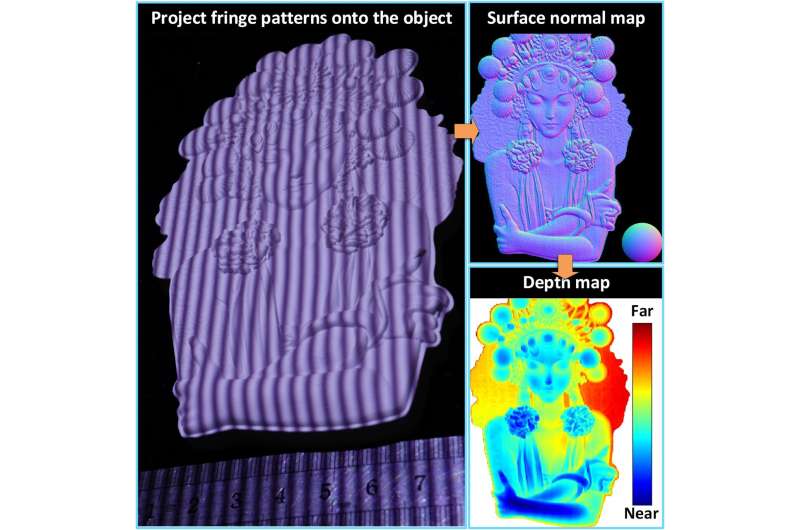Researchers have developed a faster and more accurate method for acquiring and reconstructing high-quality 3D surface measurements. The approach could greatly improve the speed and accuracy of surface measurements used for industrial inspection, medical applications, robotic vision and more.
“Traditional 3D imaging works by comparing two viewpoints, similar to how our eyes work together to judge depth,” said research team leader Ce Zhu from the University of Electronic Science and Technology of China.
“In contrast, our new approach ‘feels’ the surface by projecting light patterns, almost like running a hand over it to detect changes. This can reduce the number of patterns used by more than two-thirds, which greatly speeds up the scanning process, and surprisingly, is even more accurate than the old technique.”
In Optica the researchers describe their new fringe photometric stereo method and show that it can achieve high frame rates and micrometer-level accuracy while halving the noise variance.
“Our approach is ideal for applications demanding real-time scanning, including industrial applications like detecting defects in printed circuit boards, batteries or oil pipelines, as well as medical procedures such as diagnostics and implant customization,” said Zhu. “It could also help advance robotics by improving human-robot interaction or offering vision guidance for tasks like folding clothes.”
Faster acquisition time
Precise 3D surface measurements and reconstructions are typically acquired using a fringe projection profilometry method known as phase-shifting profilometry. Using this approach, a series of phase-shifted light patterns are projected onto an object’s surface. The reflected images are then captured and the phase differences are analyzed to create a highly accurate 3D map of the surface.

However, this method isn’t useful for many applications because of its long scanning time, which primarily comes from the high number of multiple-frequency fringe images required to analyze phase differences. This step uses triangulation to take the phase data, which is limited to a specific range, and convert it into continuous values, allowing an accurate representation of the shape or surface.
In the new work, the researchers developed a way to bypass this process and significantly reduce the number of fringe images required by using one frequency only.
To test their new fringe photometric stereo technique, the researchers set up an experimental system consisting of a 1280 × 960 camera with an 8-mm lens and a projector with a resolution of 912 × 1140. They used this setup to take measurements of single objects and groups of objects with continuous surfaces, including a human hand, a paper mask, a cloth toy, gypsum geometries and clay handicrafts.
They also validated the approach using standard plane and sphere models, demonstrating that it effectively suppresses noise compared to traditional fringe projection profilometry.
Creating better prosthetics
“One application that this new method could be particularly useful for is customizing prosthetics,” says Zhu. “It can quickly acquire high-precision surface information from the residual limb, reducing errors associated with manual measurements and improving the fit of the prosthesis. This would also eliminate the need to apply plaster or other materials to the skin, making the experience much more comfortable for the patient.”
Although the method currently offers improved scanning speed and accuracy for scenes with continuous surfaces, reconstructing the depth of objects with sudden depth changes remains challenging.
The researchers are working to address this limitation by incorporating established surface reconstruction techniques from photometric stereo into their method. This should enable a wide range of promising applications and analysis of more complex scenes.
More information:
Geyou Zhang et al, Fringe Photometric Stereo, Optica (2024). DOI: 10.1364/OPTICA.531601
Citation:
Fringe photometric stereo method improves speed and accuracy of 3D surface measurements (2024, October 24)
retrieved 24 October 2024
from https://phys.org/news/2024-10-fringe-photometric-stereo-method-accuracy.html
This document is subject to copyright. Apart from any fair dealing for the purpose of private study or research, no
part may be reproduced without the written permission. The content is provided for information purposes only.

